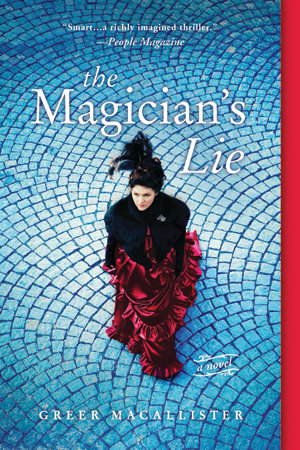 The most important element in any magician’s show is the audience. They want to believe that the trick — or the illusion — that they are seeing is real, that there is magic in the world.
The most important element in any magician’s show is the audience. They want to believe that the trick — or the illusion — that they are seeing is real, that there is magic in the world. Greer Macallister builds off of this precept in her debut novel, “The Magician’s Lie.” The drama begins when the Amazing Arden, an illusionist, is accused of killing her husband with the same ax she uses in her live show to create the dramatic illusion of cutting a man in half.
Arden, by sheer coincidence, is apprehended by a young policeman, Virgil Fecht, who happened to be in the audience the night of the murder. He takes her to the police station, where he interrogates her through the night. He becomes her one-man audience.
Arden insists she did not kill her husband and asks Virgil to listen to her story — from the beginning. It is through this retelling that we learn how Arden went from a maid to the renowned illusionist now accused of a grisly murder.
Macallister, an Iowa native and Washington, D.C., resident, has set her magical tale at the turn of the last century, when traveling stage shows were at their height and vaudeville shows crossed the country by train. The author calls herself “an accidental historical novelist.”
During her research, Macallister said, she was fascinated that there were countless references to male magicians cutting lovely female assistants in half but none about a woman magician cutting her male assistant in half. That’s when she decided she would create a female magician and to make that illusion her signature act.
“I also wanted the story to take place in reality,” she said. “In the 1880s, going out to a stage magic show was one experience a person would have had.”
As Virgil listens to the intriguing story of Arden, he is presented with the same quandary anyone who has ever gone to a magic show encounters: Do you believe it?
“He either turns her in or he doesn’t,” Macallister said.
As the night progresses, Virgil waivers back and forth about her innocence, especially as she reveals some of the more difficult situations she has encountered in the past. He also sees some of Arden’s illusions firsthand, which further clouds his thinking.
At one point in the book, Arden calls out Virgil, “And now I’m saying it. To you, Virgil.” She leans forward as far as she can, her shoulders straining, her chin thrust out. “You want to set me free? Do it. You want to turn me in? You can do that too.”
The young officer faces a terrible decision: If he turns her in, he will be famous, but if she is innocent, she will likely still be convicted of the murder, since everything points to her guilt. He’s not sure he can live with that.
Although the book is clearly a murder mystery, you might find it shelved under historical fiction at the local bookstores in an effort to broaden its appeal.
But, as Macallister points out, “There’s a dead body in the first 10 pages.”
Macallister said she likes the idea of going against the popular convention with her female protagonist cutting a man in half, but admits that such a case probably did not happen in reality until the 1980s.
“The Magician’s Lie” has been compared favorably to both “The Night Circus” and “Water for Elephants,” but it also has many of the same elements of “The Usual Suspects.” Macallister peels away at the story through a series of unusual plot twists until all is eventually revealed.
The author has already sold her second book of historical fiction to the publisher, and this time the book is based on an actual person, Kate Warne, who headed Pinkerton’s Bureau of Female Detectives. Warne is credited with being one of the detectives who saved Lincoln from an early assassination attempt in Baltimore.
“The Magician’s Lie,” much like the magic show Macallister writes about, starts slow and builds to the final illusion. Along the way, we get a glimpse of justice before widespread use of photography, when what we saw was the truth.
But, as Arden’s mentor Adelaide warns her in one of the book’s most memorable sequences, “too much truth is dangerous.” It was one of those times, when the truth was told, that leads Adelaide to turn her entire operation over to her protégé, Arden.
In retelling the story of her mentor to Virgil, she tells him, ”She taught me the tools to manipulate reality. It’s amazing how you can make people think they’re seeing something they’re not. Especially when they want to believe.”
Support City Pulse - Donate Today!
Comments
No comments on this item Please log in to comment by clicking here